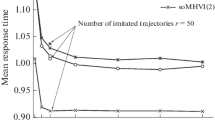Abstract
The problem of routing deterministic arriving jobs to parallel servers with deterministic service times, when the job arrival rate equals the total service capacity, requires finding a periodic routing policy. Because there exist no efficient exact procedures to minimize the long-run average waiting time of arriving jobs, heuristics to construct periodic policies have been proposed. This paper presents an aggregation approach that combines servers with the same service rate, constructs a policy for the aggregated system, and then disaggregates this policy into a feasible policy for the original system. Computational experiments show that using aggregation not only reduces average waiting time but also reduces computational effort.
Similar content being viewed by others
References
Altman, E., Gaujal, B., & Hordijk, A. (2000). Balanced sequences and optimal routing. Journal of the ACM, 47(4), 752–775.
Arian, Y., & Levy, Y. (1992). Algorithms for generalized round robin. Operations Research Letters, 12, 313–319.
Balinski, M. L., & Young, H. P. (1982). Fair representation. New Haven: Yale University Press.
Bar-Noy, A., Bhatia, R., Naor, J., & Schieber, B. (2002). Minimizing service an operation costs of periodic scheduling. Mathematics of Operations Research, 27, 518–544.
Combé, M. B., & Boxma, O. J. (1994). Optimization of static traffic allocation policies. Theoretical Computer Science, 125, 17–43.
Corominas, A., Kubiak, W., & Palli, N. M. (2007). Response time variability. Journal of Scheduling, 10, 97–110.
Hajek, B. (1985). Extremal splittings of point processes. Mathematics of Operations Research, 10, 543–556.
Herrmann, J. W. (2007). Generating cyclic fair sequences using aggregation and stride scheduling (Technical Report 2007-12). Institute for Systems Research, University of Maryland, College Park. http://hdl.handle.net/1903/7082. Accessed 1 November 2010.
Herrmann, J. W. (2008). Constructing perfect aggregations to eliminate response time variability in cyclic fair sequences (Technical Report 2008-29). Institute for Systems Research, University of Maryland, College Park. http://hdl.handle.net/1903/8643. Accessed 1 November 2010.
Herrmann, J. W. (2009a). Generating cyclic fair sequences for multiple servers. In MISTA 2009, Dublin, Ireland, August 10–12, 2009.
Herrmann, J. W. (2009b). Using aggregation to reduce response time variability in cyclic fair sequences. Journal of Scheduling. doi:10.1007/s10951-009-0127-7.
Hordijk, A., & van der Laan, D. (2005). On the average waiting time for regular routing to deterministic queues. Mathematics of Operations Research, 30(2), 521–544.
Hordijk, A., Koole, G. M., & Loeve, J. A. (1994). Analysis of a customer assignment model with no state information. Probability in the Engineering and Informational Sciences, 8, 419–429.
Kubiak, W. (2004). Fair sequences. In J. Y.-T. Leung (Ed.), Handbook of scheduling: algorithms, models and performance analysis (pp. 1–21). Boca Raton: Chapman & Hall/CRC Press.
Kubiak, W. (2009). Proportional optimization and fairness. New York: Springer.
Nowicki, E., & Smutnicki, C. (1989). Worst-case analysis of an approximation algorithm for flow shop scheduling. Operations Research Letters, 8, 171–177.
Rock, H., & Schmidt, G. (1983). Machine aggregation heuristics in shop scheduling. Methods of Operations Research, 45, 303–314.
Rogers, D. F., Plante, R. D., Wong, R. T., & Evans, J. R. (1991). Aggregation and disaggregation techniques and methodology in optimization. Operations Research, 39(4), 553–582.
Sano, S., Miyoshi, N., & Kataoka, R. (2004). m-balanced words: a generalization of balanced words. Theoretical Computer Science, 314(12), 97–120.
van der Laan, D. A. (2000). Routing jobs to servers with deterministic service times (Technical Report 2000-20). Leiden University.
van der Laan, D. A. (2003). The structure and performance of optimal routing sequences. Ph.D. thesis, Leiden University, Leiden, The Netherlands.
van der Laan, D. A. (2005). Routing jobs to servers with deterministic service times. Mathematics of Operations Research, 30(1), 195–224.
Waldspurger, C. A., & Weihl, W. E. (1995). Stride scheduling: deterministic proportional-share resource management. Technical Memorandum MIT/LCS/TM-528, MIT Laboratory for Computer Science, Cambridge, Massachusetts.
Wei, W. D., & Liu, C. L. (1983). On a periodic maintenance problem. Operations Research Letters, 2(2), 90–93.
Yum, T. P. (1981). The design and analysis of a semi-dynamic deterministic routing rule. IEEE Transactions on Communications, 29, 498–504.
Author information
Authors and Affiliations
Corresponding author
Rights and permissions
About this article
Cite this article
Herrmann, J.W. Using aggregation to construct periodic policies for routing jobs to parallel servers with deterministic service times. J Sched 15, 181–192 (2012). https://doi.org/10.1007/s10951-010-0209-6
Published:
Issue Date:
DOI: https://doi.org/10.1007/s10951-010-0209-6




